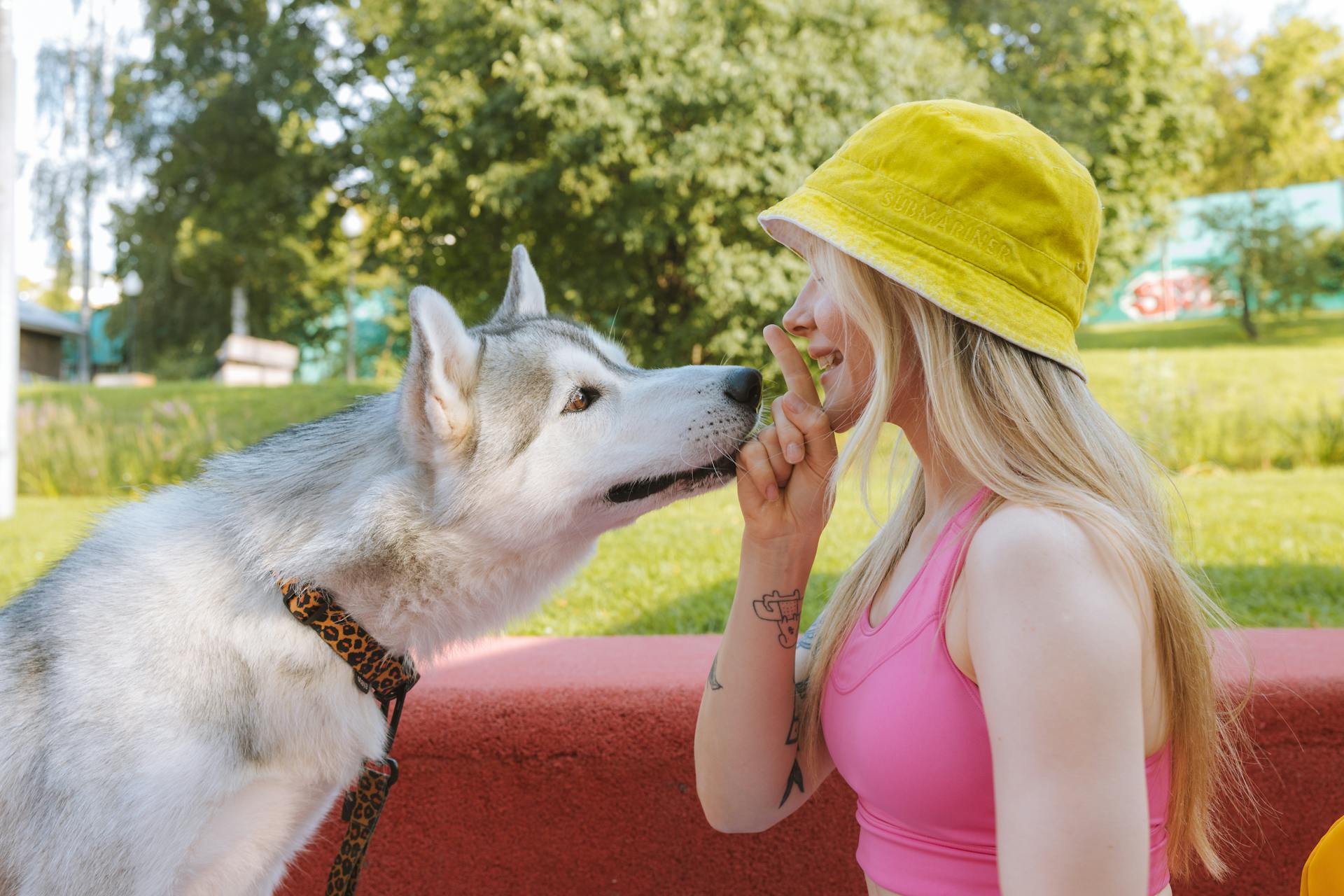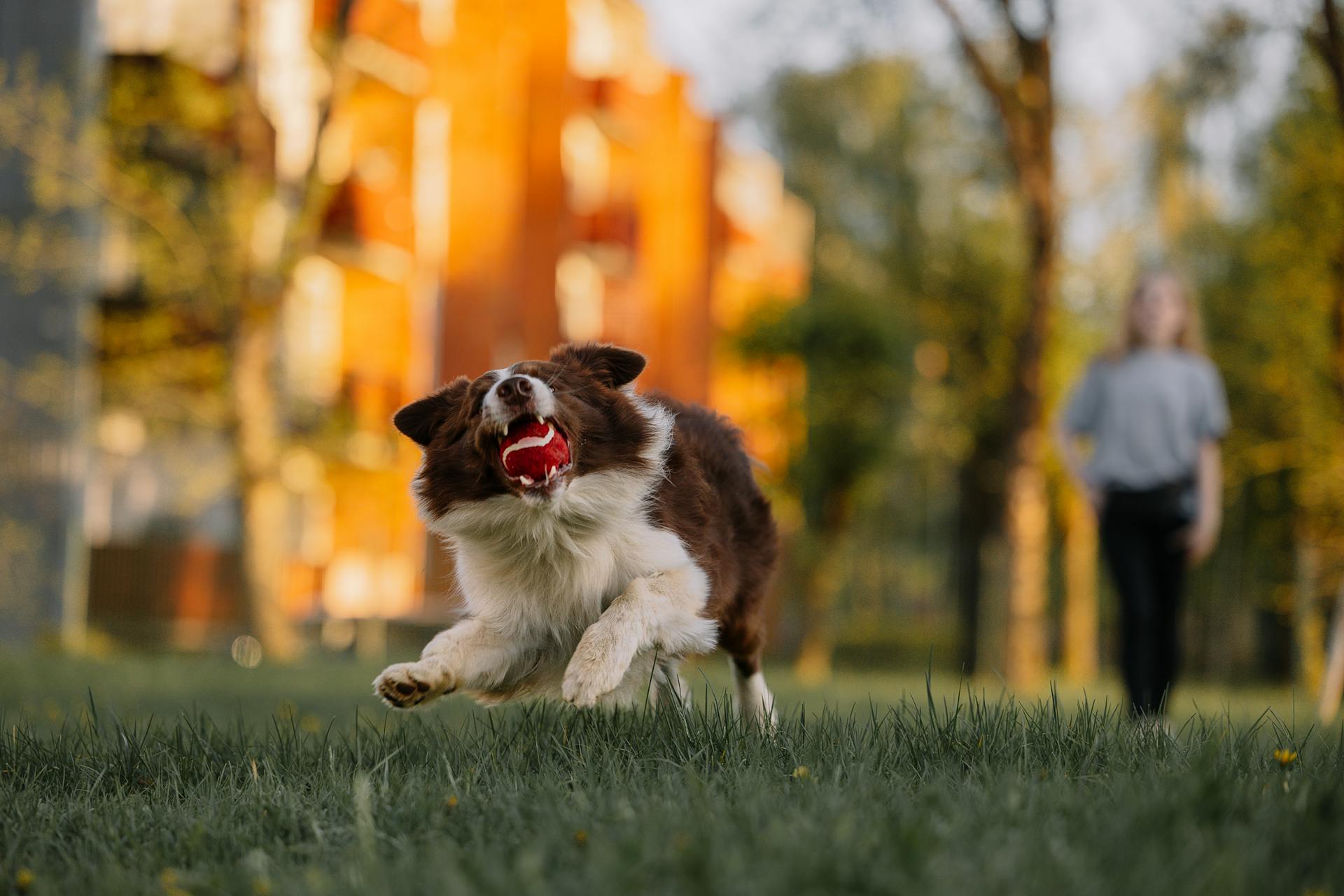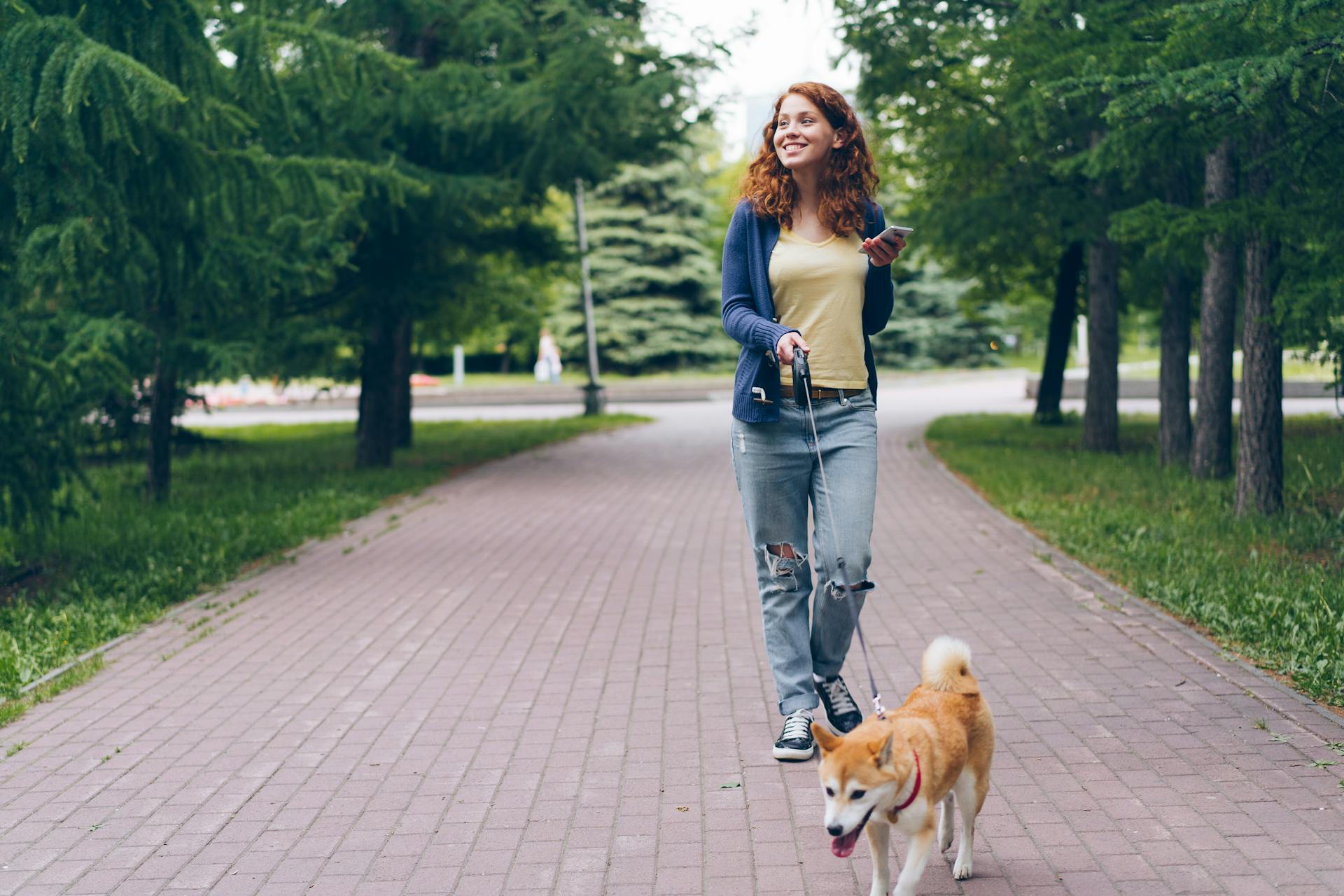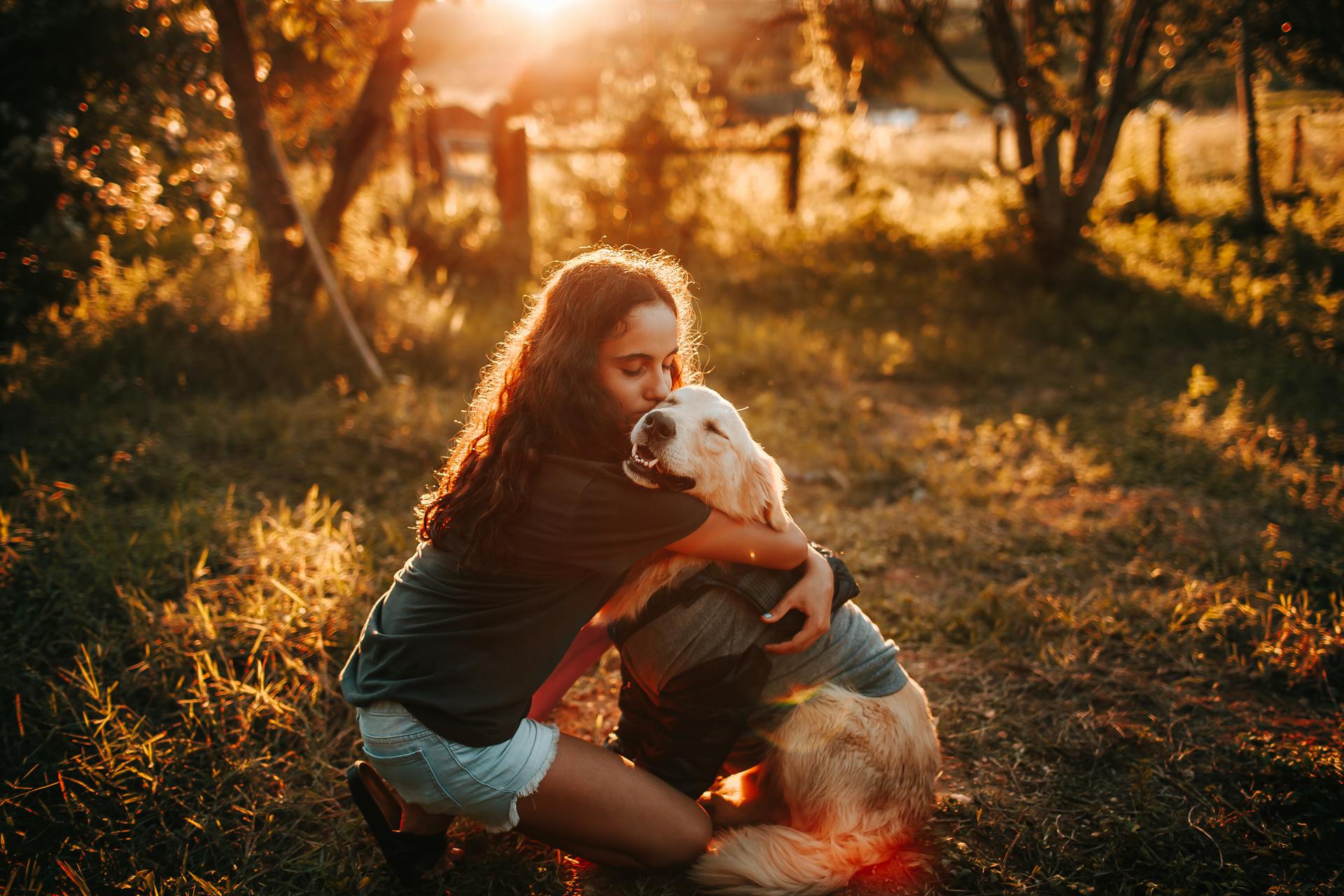
Dog recall training is a crucial aspect of dog ownership, and it's essential to start training your dog as early as possible. According to research, puppies as young as 16 weeks old can learn to respond to recall cues.
The key to successful recall training is consistency and positive reinforcement. By associating recall with rewards and praise, you can help your dog develop a strong instinct to return to you. In fact, studies have shown that dogs that receive positive reinforcement are more likely to respond to recall cues than those that don't.
Recall training can be challenging, especially for dogs that are easily distracted or have a strong prey drive. However, with patience and persistence, you can help your dog learn to focus on you and respond to recall cues.
A different take: Will Spaying Dog Stop Aggression
Preparation and Setup
To start your dog recall training journey, it's essential to prepare and set up the right tools. First, invest in a good-quality training treat pouch that can keep your treats organized and within reach.
A clicker or a marker word like "yes!" is also crucial for effective recall training. You'll need high-value training treats that your dog loves, with Vital Essentials freeze-dried minnows being a popular favorite among many canine friends.
A long leash is a must-have for recall training, as it allows you to work at a safe distance from your dog. Make sure to avoid retractable leashes, which can be hazardous. Optional, but helpful, is a training whistle that can help you get your dog's attention from a distance.
Related reading: How to Use an E Collar for Recall
What You'll Need:
To set up for recall training, you'll need a few specific items. A training treat pouch is a great investment, as it has separate compartments to keep treats organized and a waist belt to prevent them from spilling out when you move around.
For recall training, it's essential to use a clicker or a marker word like "yes!" to mark the exact moment your dog responds to the recall command.
You'll also need your dog's favorite high-value training treats. I've found that Vital Essentials freeze-dried minnows are a hit with many dogs, but be sure to choose a treat that your dog loves.
A long leash is necessary for working on long-distance recalls safely. You can attach multiple leashes together if needed, but avoid using a retractable leash as it can be hazardous.
Optional, but useful, is a training whistle to help signal your dog to come to you.
Setting Up for Success
To set up for success in recall training, it's essential to prepare high-quality treats that your dog will love. These treats will act as a lure to bring your dog to you and a reward when they finally reach you.
Start by preparing a special treat or toy that's only for recall training, making it a unique experience for your dog. This will help them associate the treats with the recall command, making it even more rewarding for them.
Take a look at this: Will Neutering a Dog Help with Aggression

Begin training recall inside with zero distractions, keeping sessions short and using your dog's focus as a gauge. If they lose interest, you can call it quits.
Get your dog accustomed to coming to you without an e-collar, teaching them three essential behaviors that will lay the foundation for successful recall training.
Choosing a Recall Word
A recall word is a specific word that you use consistently to call your dog back to you. It's essential to choose a word that's easy for your dog to recognize and respond to.
The word "here" is often effective because it's short and simple.
Worth a look: It's Your Choice Dog Training
Choose a Word
A recall word should be short, simple, and recognizable to your dog.
Use a word that's not commonly used in everyday conversations, like "let's go" or "come here", to avoid confusing your dog.
Your dog needs to associate the recall word with the action of coming back to you.
Consistency is key, so choose a word and stick to it.
Avoid using a word that sounds like a command your dog already knows, like "sit" or "stay", to prevent confusion.
A recall word should be clear and distinct, so your dog can hear it from a distance.
Check this out: Why Are German Shepherds so Clingy
Is Your Baby Ready
Is Your Baby Ready?
Your baby dog isn't ready to learn a recall word if they only listen to you when there are no distractions.
You can test this by introducing some distractions and seeing how they respond. If they don't move towards you in a low-distraction environment, it's a sign they need more practice.
To determine if your dog is ready, ask yourself these questions:
- Only listen to you when there are no distractions?
- Only perform the recall behavior when you have a high-value treat?
- Give you their attention but not actually move towards you?
If you answered yes to any of these, it's time to recondition the recall word in 4 easy steps:
- Put your dog on a leash/rope and grab some treats or something your dog finds reinforcing.
- In a low-distraction environment, say the recall word and apply pressure on the leash bringing your dog towards you.
- The second your dog begins to move in your direction, release leash pressure, praise them, and reinforce the behavior!
- Practice the recall word every day for short periods of time, always making sure you have your dog on a leash and are ready to reinforce them.
Remember, your dog needs to understand the recall word before you can layer the e-collar over it.
Teaching Recall
Teaching recall is a crucial step in dog training, and it's essential to start with a clear understanding of what the "come" cue means to your dog. The timing of your click or marker word is crucial here - don't click until they are completing the behavior.
Consider what you want your dog's recall to look like and train for that. For example, some trainers choose to consider the recall complete when they can take hold of a dog's collar, while others are fine with their dog just returning to them and staying close.
Here are some key steps to keep in mind when teaching recall:
- Entice the dog to come towards you, then say "come" just as they are about to reach you.
- Click or say "yes" as they reach you and gently grasp their collar.
- Treat! Play! Praise!
By following these steps, you'll teach your dog that coming to you is called "come" and lay the foundation for a strong recall.
Teach Your What
Teach your dog what "come" means by introducing the come cue in training. This involves enticing your dog to come towards you, then saying "come" just as they're about to reach you.
To entice your dog, you might run around like a crazy person, pat your legs or the ground, grab a squeaky toy, or make kissy noises – whatever makes them want to come towards you.
The timing of your click or marker word is crucial. Don't click until they're completing the behavior, and consider the recall complete when you can take hold of a dog's collar.
Here's a step-by-step guide to introducing the come cue:
- Entice the dog to come towards you.
- Say "come" just as they are about to reach you.
- Click or say "yes" as they reach you and you gently grasp their collar.
- Treat! Play! Praise!
Think about what you want your dog's come when called behavior to look like and train for that.
How to Teach
Teaching recall to your dog requires patience, consistency, and positive reinforcement. You should start by introducing the "come" cue in a controlled environment.
Don't say the word "come" unless your dog is already moving towards you. This will prevent confusion and ensure they associate the cue with the action. Entice your dog to come towards you using treats, toys, or play, and then say "come" just as they're about to reach you.
Timing is crucial when teaching recall. Click or say "yes" (if using a marker word) as your dog reaches you and you grasp their collar. This marks the exact moment they've completed the behavior. Treat, play, and praise your dog to reinforce the positive association.
You may choose to define recall as your dog coming back to you and sitting, or simply returning to you and staying close. The key is to establish a clear understanding of what you want your dog to do. Consider what you want your dog's recall to look like and train for that specific behavior.
Broaden your view: Say Yes Dog Training
Here are some key steps to keep in mind when teaching recall:
Training Techniques
To make recall training a fun experience for your dog, try turning it into a game with recall games like Ping Pong, where you and your family members take turns calling your dog. This is an excellent way to train your dog and your family how recall works.
You can also practice recall games like Catch Up, where you call your dog while leash-walking and turn away, issuing your recall command as they chase after you. Reward your dog with higher-value treats and a training toy to make it a positive experience.
To practice recall outdoors, start with short distances and gradually increase the distance over time. Use treats or toys as rewards when your dog reaches you promptly, and make the reward for coming when called better than usual when practicing around new distractions.
Here are some tips for practicing recall walks:
- Start with shorter distances and gradually increase the distance over time.
- Use treats or toys as rewards when your dog reaches you promptly.
- Make the reward for coming when called better than usual when practicing around new distractions.
Fun Games

Making recall training a game is a great way to keep your dog engaged and motivated. Try playing Ping Pong with your dog, where you and your family members take turns calling your dog and rewarding them with treats.
To make it more challenging and fun, you can play Catch Up while leash-walking your dog. Call for them and turn away, issuing your recall command as they chase after you for a few steps.
Another fun game is Hide and Seek, where you call your recall command while in a different room, and reward your dog when they find you.
Here are some tips to keep in mind when playing these games:
- Use high-value treats to reward your dog's good behavior.
- Make the reward better than usual when practicing around new distractions.
- Start with short distances and gradually increase the distance as your dog becomes more reliable.
Remember to have fun and be creative with your recall games!
Practicing Focus Around Distractions
As you practice recall training with your dog, it's essential to focus on their ability to respond to the cue in the presence of distractions. Start by training in a quiet area with minimal distractions, such as a hallway or family room.
You might like: Dog Training with Distractions
To build on this foundation, you can gradually introduce distractions like toys, chews, family members, or other dogs to call your dog away from. This will help them learn to focus on you despite the presence of other stimuli.
One way to do this is to practice recall in different locations, such as a park or backyard. Begin by allowing your dog some freedom to explore, but intermittently call them to come using the recall command. As they become more reliable, you can increase the difficulty by introducing distractions like toys or other dogs.
To ensure successful training, it's helpful to use a long leash outdoors. This will allow you to manage your dog's tolerance threshold and build impulse control into the training. It also gives you a way to help them come to you when called, if they have trouble following the cue.
Here are some recall games you can play with your dog to make training more engaging and fun:
- Ping Pong: You and your family members each have treats and take turns calling your dog, an excellent way to train your dog and your family how recall works.
- Catch Up: While leash-walking your dog, call for them and turn away, issuing your recall command as they chase after you for a few steps.
- Hide and Seek: Call your recall command while in a different room, and reward your dog when they find you.
Remember to practice recall training in a variety of settings and with increasing distractions to help your dog generalize the behavior.
Training Techniques

To start training your dog's recall skills, try incorporating Leashed Recall Walks into your regular walks. Start with shorter distances and gradually increase the distance over time.
Use treats or toys as rewards when your dog reaches you promptly. This exercise strengthens recall skills while adding distractions and reinforcing the behavior on-leash.
To effectively teach your dog to respond to the recall command, use an e-collar and follow the order: say the word "come", then press on the nick or tap the continuous button briefly to encourage your dog to complete the "come" behavior.
It's essential to note that the timing of pressing and releasing the button to deliver stimulation is of the highest importance, so the stimulation should disappear the instant your dog starts to perform the command.
To find the right e-collar settings, start at level 5 and slowly dial-up, watching for any reaction from your dog, even a slight ear twitch or eyes blinking can be an indicator that your dog feels the stimulation.
A unique perspective: Button Training Dog

Pair the stimulation with a reward like a treat or praise when your dog shows you they feel it, and you'll be on your way to successful recall training.
To take your recall training to the next level, try Recall with Distractions in a quiet outdoor area with mild distractions, such as a park or a backyard.
Frequently Asked Questions
What to do when your dog ignores your recall?
Stay calm and gently guide your dog back with a long line, avoiding physical force or pulling. If they don't respond, consider going to collect them instead
Can you teach a 2 year old dog recall?
Teaching recall to a 2-year-old dog requires commitment and effort to overcome existing habits. With consistent training, you can help your dog develop reliable recall
Is it too late to teach my dog recall?
No, it's never too late to teach your dog recall, even if you have an older dog. With patience and consistency, you can still establish a strong recall habit with your furry friend.
How long does it take to train a dog to recall?
Training a dog to recall can take anywhere from 3-6 months, depending on consistency and gradual progress. With patience and proper training, your dog can learn to recall in a relatively short period of time.
Sources
- https://www.preventivevet.com/dogs/how-to-teach-your-dog-to-come-when-called
- https://www.dogster.com/dog-training/how-to-teach-your-dog-recall
- https://theonlinedogtrainer.com/dog-recall-training-tips-make-dogs-come/
- https://www.dogtra.com/blog-and-events/recall-command
- https://eastcoastdogtraining.co.uk/how-to-use-a-long-line/
Featured Images: pexels.com


